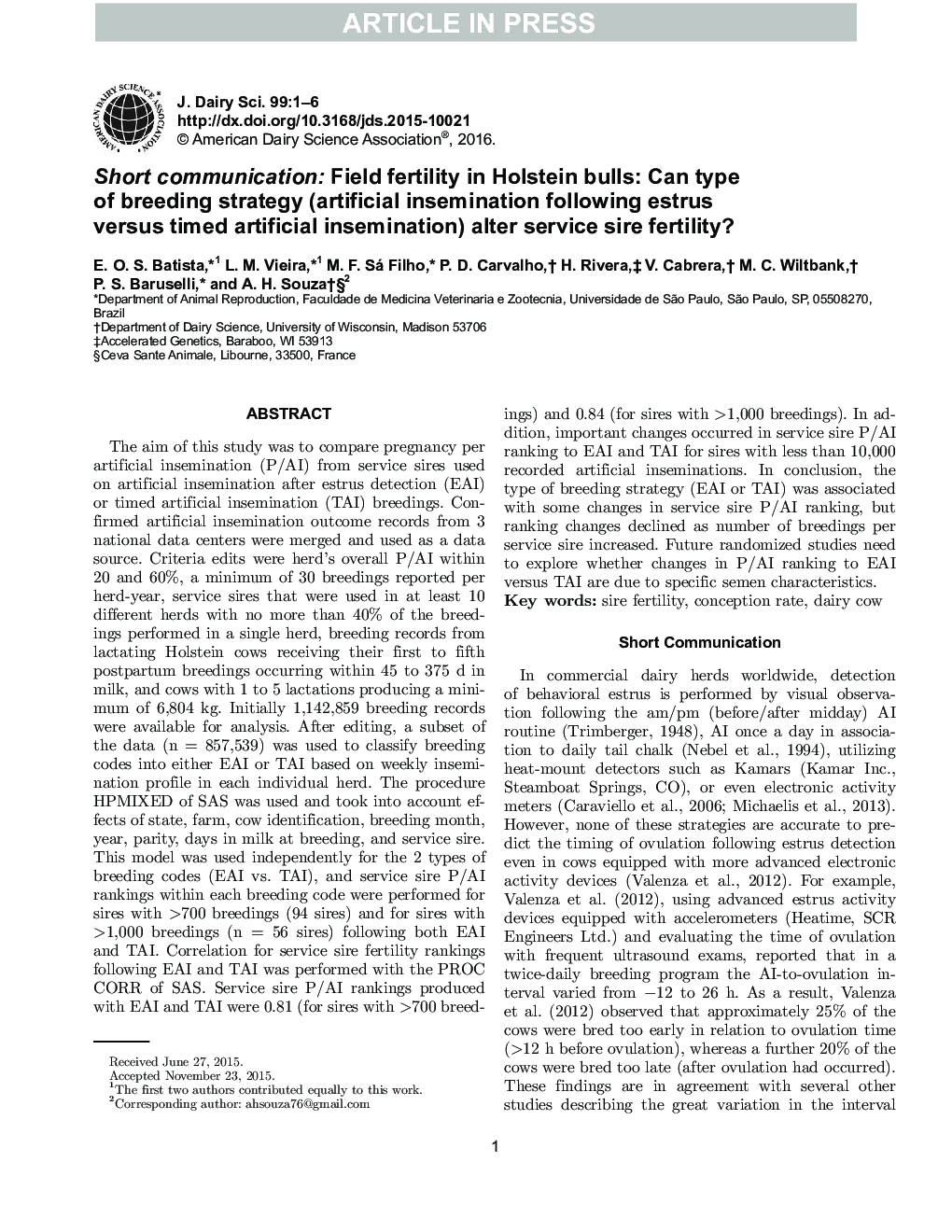| کد مقاله | کد نشریه | سال انتشار | مقاله انگلیسی | نسخه تمام متن |
|---|---|---|---|---|
| 10973236 | 1108012 | 2015 | 6 صفحه PDF | دانلود رایگان |
عنوان انگلیسی مقاله ISI
Short communication: Field fertility in Holstein bulls: Can type of breeding strategy (artificial insemination following estrus versus timed artificial insemination) alter service sire fertility?
ترجمه فارسی عنوان
ارتباطات کوتاه: باروری میدان در گاوهای هلشتاین: آیا می توان نوع استراتژی پرورش (تلقیح مصنوعی پس از استراحت در برابر تلقیح مصنوعی به موقع) باعث تغییر عملکرد باروری می شود؟
دانلود مقاله + سفارش ترجمه
دانلود مقاله ISI انگلیسی
رایگان برای ایرانیان
کلمات کلیدی
باروری خرس نرخ تخمکگذاری، گاو شیری،
موضوعات مرتبط
علوم زیستی و بیوفناوری
علوم کشاورزی و بیولوژیک
علوم دامی و جانورشناسی
چکیده انگلیسی
The aim of this study was to compare pregnancy per artificial insemination (P/AI) from service sires used on artificial insemination after estrus detection (EAI) or timed artificial insemination (TAI) breedings. Confirmed artificial insemination outcome records from 3 national data centers were merged and used as a data source. Criteria edits were herd's overall P/AI within 20 and 60%, a minimum of 30 breedings reported per herd-year, service sires that were used in at least 10 different herds with no more than 40% of the breedings performed in a single herd, breeding records from lactating Holstein cows receiving their first to fifth postpartum breedings occurring within 45 to 375 d in milk, and cows with 1 to 5 lactations producing a minimum of 6,804 kg. Initially 1,142,859 breeding records were available for analysis. After editing, a subset of the data (n = 857,539) was used to classify breeding codes into either EAI or TAI based on weekly insemination profile in each individual herd. The procedure HPMIXED of SAS was used and took into account effects of state, farm, cow identification, breeding month, year, parity, days in milk at breeding, and service sire. This model was used independently for the 2 types of breeding codes (EAI vs. TAI), and service sire P/AI rankings within each breeding code were performed for sires with >700 breedings (94 sires) and for sires with >1,000 breedings (n = 56 sires) following both EAI and TAI. Correlation for service sire fertility rankings following EAI and TAI was performed with the PROC CORR of SAS. Service sire P/AI rankings produced with EAI and TAI were 0.81 (for sires with >700 breedings) and 0.84 (for sires with >1,000 breedings). In addition, important changes occurred in service sire P/AI ranking to EAI and TAI for sires with less than 10,000 recorded artificial inseminations. In conclusion, the type of breeding strategy (EAI or TAI) was associated with some changes in service sire P/AI ranking, but ranking changes declined as number of breedings per service sire increased. Future randomized studies need to explore whether changes in P/AI ranking to EAI versus TAI are due to specific semen characteristics.
ناشر
Database: Elsevier - ScienceDirect (ساینس دایرکت)
Journal: Journal of Dairy Science - Volume 99, Issue 3, March 2016, Pages 2010-2015
Journal: Journal of Dairy Science - Volume 99, Issue 3, March 2016, Pages 2010-2015
نویسندگان
E.O.S. Batista, L.M. Vieira, M.F. Sá Filho, P.D. Carvalho, H. Rivera, V. Cabrera, M.C. Wiltbank, P.S. Baruselli, A.H. Souza,
